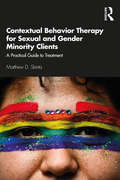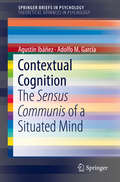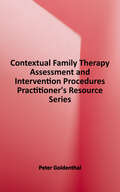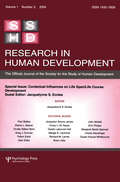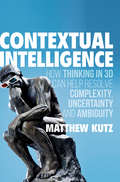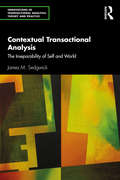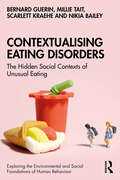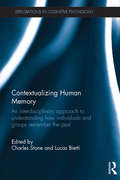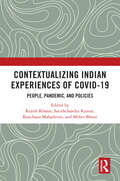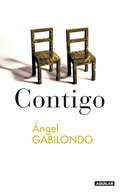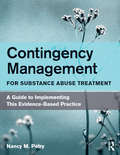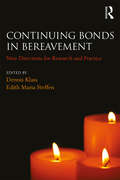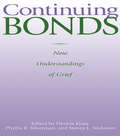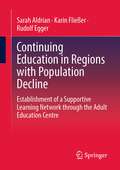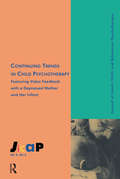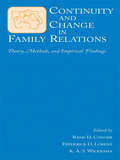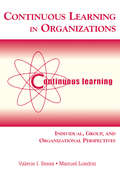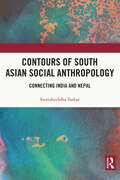- Table View
- List View
Contextual Behavior Therapy for Sexual and Gender Minority Clients: A Practical Guide to Treatment
by Matthew D. SkintaCombining theory, research, and case studies, this book shows clinicians how to apply transdiagnostic contextual behavioral approaches when working with sexual and gender minority (SGM) clients. The text first examines minority stress theory through the lens of contextual behavior analysis. Subsequent chapters illustrate the application of therapeutic techniques drawn from acceptance and commitment therapy, functional analytic psychotherapy, and compassion-focused therapy. The book concludes with a close look at special areas of consideration, including pre-surgical evaluation, the impact of HIV on SGM communities, ethical considerations, and future directions in therapy with SGM clients. Every chapter provides a series of diverse vignettes that illustrate how each aspect of treatment might build upon the last along with a list of recommended books for further exploration of that topic. This book offers a unique, integrated approach that can be used for case conceptualization and followed as a treatment manual for professionals or graduate students with a foundation in SGM psychology.
Contextual Cognition: The Sensus Communis of a Situated Mind (SpringerBriefs in Psychology)
by Agustín Ibáñez Adolfo M. GarcíaThis Brief introduces two empirically grounded models of situated mental phenomena: contextual social cognition (the collection of psychological processes underlying context-dependent social behavior) and action-language coupling (the integration of ongoing actions with movement-related verbal information). It combines behavioral, neuroscientific, and neuropsychiatric perspectives to forge a novel view of contextual influences on active, multi-domain processes. Chapters highlight the models' translational potential for the clinical field by focusing on diseases compromising social cognition (mainly illustrated by behavioral variant frontotemporal dementia) and motor skills (crucially, Parkinson’s disease). A final chapter sets forth metatheoretical considerations regarding intercognition, the constant binding of processes triggered by environmental and body-internal sources, which confers a sensus communis to our experience. In addition, the book includes two commentaries written by external peers pondering on advantages and limits of the proposal. Contextual Cognition will be of interest to students, teachers, and researchers from the fields of cognitive science, neurology, psychiatry, neuroscience, psychology, behavioral science, linguistics, and philosophy.
Contextual Family Therapy: Assessment and Intervention Procedures
by Peter GoldenthalThis book illustrates the varied applications of Ivan Boszormenyi-Nagy's model for helping individuals better negotiate relationships. It provides a unique and powerful integrative approach to the treatment of individuals, couples, and families, by addressing four dimensions simultaneously: individual and family history, individual psychological issues, family transactions and power issues, and issues related to fairness in relationships.
Contextual Influences on Life Span/life Course: A Special Issue of Research in Human Development
by Jacquelynne S. EcclesThis special issue covers different aspects of life course development. The central argument of the first paper is that human development should be viewed as the product of the interpenetration of cultural and biological processes. The following article outlines how current sociology constructs life courses. The notion of developmental biocultural co-constructivism and specifically the zone within which human development can be expressed is the focus of the third paper. Next, a developmental account of civic engagement and political participation is provided. Finally, the special issue concludes with a paper marking individual differences in patterns of rhesus monkey biobehavioral development through the life span.
Contextual Intelligence: How Thinking in 3D Can Help Resolve Complexity, Uncertainty and Ambiguity
by Matthew KutzThis book offers a structured framework for critical thinking and decision making that shows how to use hindsight, insight, and foresight to navigate through complexity. Every organization and every person faces rapid change and complexity. Contextual intelligence - understanding fully the context in which one is operating - teaches the reader how to navigate that complexity and respond appropriately in the face of change (expected and unexpected). The Three-Dimensional (3D) Thinking(tm) framework helps structure critical thinking by showing how to appropriately bring past experience, present intuition, and future ambiguity- in other words: hindsight, insight, and foresight - to bear on any given problem. Kutz offers a way to rationally organize difficult concepts such as complexity, tacit knowledge, and synchronicity into usable and understandable language, but more importantly teaches the reader how to apply these concepts in a very practical and meaningful way with measurable and tangible outcomes. The book also describes in detail 12 behaviors associated with contextual intelligence. Four behaviors are associated with hindsight, four behaviors are associated with insight, and four behaviors are associated with foresight. The book takes the reader through the 12 behaviors and how they relate to 3D Thinking. Cases and anecdotes are used generously to provide examples. Chapters are followed by critical thinking questions and questions related to the cases in the chapters. Furthermore, questions and practical tools are introduced that help the reader assess and determine their level of contextual intelligence.
Contextual Therapy for Family Health: Clinical Applications
by Alexandra E. Schmidt Hulst D. Scott SibleyThis book provides readers with a compelling case for the inclusion of contextual therapy in comprehensive healthcare settings by presenting its applications to individual and family health across the lifespan. Part I gives an overview of contextual therapy, including case conceptualization, assessment, intervention, and supervision. Part II provides specific recommendations for incorporating contextual therapy in diverse and multidisciplinary settings. Case studies illustrate how concepts such as justice, loyalty, and balanced giving and receiving influence families’ adjustment to chronic illnesses and mental health disorders. Accounting for the trend toward increased collaboration between providers in traditional mental health and medical settings, this book will empower clinicians to expand their current range of assessment methods, intervention techniques, and supervision experiences
Contextual Transactional Analysis: The Inseparability of Self and World (Innovations in Transactional Analysis: Theory and Practice)
by James M. SedgwickContextual Transactional Analysis: The Inseparability of Self and World offers a novel and comprehensive reworking of key concepts in transactional analysis, offering insight into the causes of psychological distress and closing the gap between training and clinical practice. By providing a bigger picture – as much sociological as psychological – of what it means to be human, the book makes an essential contribution to current debates about how best to account for and work with the social and cultural dimensions of client experience. James M. Sedgwick captures the ongoing importance of what happens around us and the distinctive kinds of psychological distress that arise from persistent and pervasive environmental disadvantage. Beginning with a view of people as always situated and socialised, the book highlights the many ways that the world always and everywhere constrains or enables thought and action. Ranging through ideas about the kinds of contextual conditions which might make psychological distress more likely and illuminating the complex relationship between socialisation and autonomy, the book suggests what the implications of these conclusions might be for clinical understanding and practice. Sedgwick’s insightful and compassionate work revises the theoretical framework, fills a current gap in the clinical literature and points the way to greater practitioner efficacy. Contextual Transactional Analysis will be an insightful addition to the literature for transactional analysts in practice and in training, for professionals interested in the theory and practice of transactional analysis and anyone seeking to understand the contribution of context to psychological distress.
Contextualising Eating Disorders: The Hidden Social Contexts of Unusual Eating (Exploring the Environmental and Social Foundations of Human Behaviour)
by Bernard Guerin Millie Tait Scarlett Kraehe Nikia BaileyThis book rethinks the diagnosis and treatment of eating disorders by putting the spotlight on their social and societal contexts, examining how these behaviours are shaped by the difficult life conditions of those suffering.Drawing on the lived experiences of nine women, this book uses in-depth case studies and interviews to discuss eating disorders with a Social Contextual Analysis framework. It prioritises the women’s own voices about their life conditions and recovery to explore the behaviour of unusual eating patterns. The book identifies common social properties across the nine women, which will become essential context when considering treatment and therapy for unusual eating. Through this more compassionate approach, readers are presented with a detailed example of new ways to analyse and treat the behaviours of mental health and therapy outside of a DSM diagnosis.Contextualising Eating Disorders is unique in its focus on giving priority to women’s voices and the social contexts behind unusual eating and will be highly relevant for all professionals working with those with unusual eating patterns, as well as students and academics in the fields of social psychology and mental health. This book will also benefit those who themselves are suffering from unusual eating patterns they might not understand.
Contextualizing Human Memory: An interdisciplinary approach to understanding how individuals and groups remember the past (Explorations in Cognitive Psychology)
by Charles B. Stone and Lucas M. BiettiThis edited collection provides an inter- and intra-disciplinary discussion of the critical role context plays in how and when individuals and groups remember the past. International contributors integrate key research from a range of disciplines, including social and cognitive psychology, discursive psychology, philosophy/philosophical psychology and cognitive linguistics, to increase awareness of the central role that cultural, social and technological contexts play in determining individual and collective recollections at multiple, yet interconnected, levels of human experience. Divided into three parts, cognitive and psychological perspectives, social and cultural perspectives, and cognitive linguistics and philosophical perspectives, Stone and Bietti present a breadth of research on memory in context. Topics covered include: the construction of self-identity in memory flashbulb memories scaffolding memory the cultural psychology of remembering social aspects of memory the mnemonic consequences of silence emotion and memory eyewitness identification multimodal communication and collective remembering. Contextualizing Human Memory allows researchers to understand the variety of work undertaken in related fields, and to appreciate the importance of context in understanding when, how and what is remembered at any given recollection. The book will appeal to researchers, academics and postgraduate students in the fields of cognitive and social psychology, as well as those in related disciplines interested in learning more about the advancing field of memory studies.
Contextualizing Immigrant and Refugee Resilience: Cultural and Acculturation Perspectives (Advances in Immigrant Family Research)
by Dagmar Strohmeier Derya GüngörThis book offers a comprehensive overview of resilience across immigrant and refugee populations. It examines immigrant and refugee strengths and challenges and explores what these experiences can impart about the psychology of human resilience. Chapters review culture functions and how they can be used as a resource to promote resilience. In addition, chapters provide evidence-based approaches to foster and build resilience. Finally, the book provides policy recommendations on how to promote the well-being of immigrant and refugee families. Topics featured in this book include:Methods of cultural adaptation and acculturation by immigrant youth.Educational outcomes of immigrant youth in a European context.Positive adjustment among internal migrants.Experiences of Syrian and Iraqian asylum seekers.Preventive interventions for immigrant youth.Fostering cross-cultural friendships with the ViSC Anti-Bullying Program. Contextualizing Immigrant and Refugee Resilience is a must-have resource for researchers, professors, graduate students as well as clinicians, professionals, and policymakers in the fields of developmental, social, and cross-cultural psychology, parenting and family studies, social work, and all interrelated disciplines.
Contextualizing Indian Experiences of Covid-19: People, Pandemic, and Policies
by Edited by Rajesh Kharat, Satishchandra Kumar, Kanchana Mahadevan, and Meher BhootThis volume captures the social, political, psychological, administrative, and policy dimensions of the COVID-19 pandemic in the Indian context. The book is divided into four parts. Part I highlights social narratives from underprivileged workers, ASHA workers, the LGBTIQ+ community, and sanitary workers. It documents their struggles to develop mitigation, adaptation, and resilience strategies. Part II includes case studies and stories of self-management, the mental health of students from rural and urban Maharashtra, and of caregivers. It unveils the path of transformation of self to deal with the issues of anxiety and emotional turmoil caused during and due to the COVID-19 pandemic. Part III consists of resilience, philosophical hope, and solidarity, which reflect the contribution of seva by the Sikh community. It also highlights the contribution of government organizations like Indian Railways, Air India, and the Employee Provident Fund Organization to provide relief to both the people of India and Indians residing abroad to bring people back to the country during the unprecedented times. Part IV discusses the responses of various states of India to the COVID-19 pandemic and the implementation of policies by the government of India during those times.Based on empirical research work, this book will be useful for students, teachers, researchers, behavioral scientists, and practitioners of psychology, sociology, human geography, mental health, political science, public health, and public policy. This book will also be of interest to policymakers and the general public to understand the intricacies involved and the essential propositions with regard to pandemics.
Contigo
by Ángel GabilondoÁngel Gabilondo recupera la palabra que nos falta, la que a menudo callamos, y nos anima a intensificar la pasión de buscar, de perseguir, de rememorar y de conformar una nueva posibilidad, una realidad diferente que nos acerque. «Contigo es menos difícil»Ángel Gabilondo No siempre encontramos las palabras adecuadas. En ocasiones éstas se desvanecen antes de llegar. Se produce entonces una sensación incómoda de incomunicación. Lamentamos no haber sido capaces de verbalizar lo que pensamos o sentimos. Todos necesitamos de alguien que nos hable, que nos abrace, que nos descubra. Convivir y compartir sin apenas decirnos nada acaba por impedir los sueños y los deseos que nos completan en compañía del otro. Contigo nos sitúa en el espacio donde se produce la ruptura entre lo que nos sucede y lo que decimos, en el entorno de aquello que nuestros labios se reservan, en el territorio de los encuentros que son también desencuentros. En él nos sorprenden los sueños y los deseos, las dudas, la incertidumbre, la añoranza y allí nos damos cuenta de que «contigo», con alguien, es todo menos difícil.
Continental Philosophy of Psychiatry: The Lure of Madness
by Alastair MorganThis book explores how the continental philosophical tradition in the 20th century attempted to understand madness as madness. It traces the paradoxical endeavour of reason attempting to understand madness without dissolving the inherent strangeness and otherness of madness. It provides a comprehensive overview of the contributions of phenomenology, critical theory, psychoanalysis, post-structuralism and anti-psychiatry to continental philosophy and psychiatry. The book outlines an intellectual tradition of psychiatry that is both fascinated by and withdraws from madness. Madness is a lure for philosophy in two senses; as both trap and provocation. It is a trap because this philosophical tradition constructs an otherness of madness so profound, that it condemns madness to silence. However, the idea of madness as another world is also a fertile provocation because it respects the non-identity of madness to reason. The book concludes with some critical reflections on the role of madness in contemporary philosophical thought.
Contingency Management for Substance Abuse Treatment: A Guide to Implementing This Evidence-Based Practice
by Nancy M. PetryIsn’t it unethical to pay people to do what they should be doing anyway?Won’t patients just sell the reinforcers and buy drugs?Others didn’t get prizes for not using. Why should they?The concerns surrounding Contingency Management (CM) are many and reflect how poorly understood and rarely utilized this evidence-based treatment model is in practice settings. Despite being identified as the most efficacious intervention for substance use disorders, a significant gap persists between research and practice, at the client’s expense. Nancy Petry, an experienced researcher and consultant for organizations such as the National Institute of Health, has begun to fill this gap by authoring the first clinician-oriented text that focuses on CM protocol development and implementation. In this well-organized and clear book she provides a foundation for understanding CM and details how to design and implement a program that can work for any clinician, whether he or she works for a well-funded program or not. She also addresses realistic concerns such as:How to describe CM to eligible and ineligible patientsHow to calculate the costs of CM interventionsHow to solicit donations and raise funds to support CM interventionsHow to stock a prize cabinet and keep track of prizesOver 50 charts, worksheets, and tables are provided to help the clinician pinpoint exactly which behaviors to target, brainstorm how to reinforce change, and develop a treatment plan that incorporates cost, length of treatment, and method for determining patient compliance. Included with the book are downloadable resources of editable logs, forms, tables, and worksheets for personal use. More than just filling a void, Dr. Petry provides all of the tools clinicians require to successfully apply a novel treatment in practice.
Contingent Valuation of Yangtze Finless Porpoises in Poyang Lake, China
by Yanyan DongThis book presents the findings of the study, and offers analysis of both its methodological and policy-related implications. On the methodology side, it assesses and validates the valuation workshop approach; appraises the effect of distance on willingness to pay and the influence of the respondents' ability to pay. From a policy perspective, the book examines the attitudes and preference of respondents on trade-offs between economic growth and ecological use.
Continual Permutations of Action
by Anselm L. StrsussRichard Bernstein expressed the view that pragmatism was ahead of its time; the same has been true of symbolic interactionism. These two closely related perspectives, one philosophical and the other sociological, place human action at the center of their explanatory schemes. It has not mattered what aspect of social or psychological behavior was under scrutiny. Whether selves, minds, or emotions, or institutions, social structures, or social change, all have been conceptualized as forms of human activity. This view is the simple genius of these perspectives. Anselm Strauss always took ideas pertaining to action and process seriously. Here he makes explicit the theory of action that implicitly guided his research for roughly forty years. It is understood that Strauss accepts the proposition that acting (or even better, interacting) causes social structure. He lays the basis for this idea in the nineteen assumptions he articulates early in the book--assumptions that elaborate and make clearer Herbert Blumer's famous premises of symbolic interactionism. The task Strauss put before himself is how to keep the complexity of human group life in front of the researcher/theorist and simultaneously articulate an analytical scheme that clarifies and reveals that complexity. With these two imperfectly related issues before him, Strauss outlines an analytical scheme of society in action. It is a scheme that rests not on logical necessity but on research and observation, and the concepts he uses are proposed because they do a certain amount of analytical work. One would be well advised to take Continual Permutations of Action very seriously.
Continuing Bonds in Bereavement: New Directions for Research and Practice (Series in Death, Dying, and Bereavement)
by Dennis Klass Edith Maria SteffenThe introduction of the continuing bonds model of grief near the end of the 20th century revolutionized the way researchers and practitioners understand bereavement. Continuing Bonds in Bereavement is the most comprehensive, state-of-the-art collection of developments in this field since the inception of the model. As a multi-perspectival, nuanced, and forward-looking anthology, it combines innovations in clinical practice with theoretical and empirical advancements. The text traces grief in different cultural settings, asking questions about the truth in our interactions with the dead and showing how new cultural developments like social media change the ways we relate to those who have died. Together, the book’s four sections encourage practitioners and scholars in both bereavement studies and in other fields to broaden their understanding of the concept of continuing bonds.
Continuing Bonds: New Understandings of Grief (Death Education, Aging and Health Care)
by Dennis Klass, Phyllis R. Silverman and Steven L. NickmanFirst published in 1996. This new book gives voice to an emerging consensus among bereavement scholars that our understanding of the grief process needs to be expanded. The dominant 20th century model holds that the function of grief and mourning is to cut bonds with the deceased, thereby freeing the survivor to reinvest in new relationships in the present. Pathological grief has been defined in terms of holding on to the deceased. Close examination reveals that this model is based more on the cultural values of modernity than on any substantial data of what people actually do. Presenting data from several populations, 22 authors - among the most respected in their fields - demonstrate that the health resolution of grief enables one to maintain a continuing bond with the deceased. Despite cultural disapproval and lack of validation by professionals, survivors find places for the dead in their on-going lives and even in their communities. Such bonds are not denial: the deceased can provide resources for enriched functioning in the present. Chapters examine widows and widowers, bereaved children, parents and siblings, and a population previously excluded from bereavement research: adoptees and their birth parents. Bereavement in Japanese culture is also discussed, as are meanings and implications of this new model of grief. Opening new areas of research and scholarly dialogue, this work provides the basis for significant developments in clinical practice in the field.
Continuing Education in Regions with Population Decline: Establishment of a Supportive Learning Network through the Adult Education Centre
by Rudolf Egger Sarah Aldrian Karin FließerIn this book, the basic conditions for local learning are described using the example of two regions in Styria and related to demographic and spatial factors. Based on this, possibilities for successful local learning in peripheral regions are elaborated and the role of the Adult Education Centre in the regions of south-eastern Styria and Liezen is analysed.The contentBuilding a supportive learning network for people in peripheral regions - Regional profiles - Basic educational conditions in the regions of Liezen and Southeast Styria - Profile of the Adult Education Centre of Styria - The role of the Adult Education Centre in the regions of Liezen and Southeast Styria - Local learning - Challenges and opportunities from the perspective of regional experts - Social and regional benefits of the Adult Education Centres in the districts of Liezen and Southeast StyriaThe authorsSarah Aldrian and Karin Fließer are research assistants at the Institute for Education and Educational Science at the Karl-Franzens-University Graz.Dr. Rudolf Egger is a university professor for empirical learning environment research and university didactics at the Institute for Education and Educational Science at the Karl Franzens University of Graz.
Continuing Trends: Journal of Infant, Child, and Adolescent Psychotherapy, 2.3
by Kirkland C. VaughansThis new issue of JICAP features some of the most engaging material yet on the subject of treating depressed mothers and their small children. It opens with "Video Feedback with a Depressed Mother and Her Infant," the presentation of an unusual collaborative individual psychoanalytic treatment written by Phyllis Cohen and Beatrice Beebe that is one of the most unique studies on the subject to date. This brilliant introductory article is followed up by a well-executed analysis of the treatment from Phyllis Ackman and a smart commentary by Anni Bergman. The issue continues with a thorough examination of the changing role that play instruments have in child psychotherapy over the course of the analysis in a strong article co-written by Saralea Chazan and Jonathan Wolf. The active aspects of object relations are discussed next by Marcia Kaufman, followed by a special look at the influence of culture on therapy in Carmen Vazquez and Lorna Myers' piece "The Case of Alicia: Understanding Selective Mutism and Alopecia within a Cultural Framework." The issue continues with Debbie Hindle's take on the vagaries of self-help with "I'm Not Smiling, I'm Frowning Upside Down" and closes with Kate Henderson's account of a session with a group of latency children.
Continuity and Change in Art: The Development of Modes of Representation
by Sidney J. Blatt Ethel S. BlattThe representation of the form of objects and of space in painting, from paleolithic through contemporary time, has become increasingly integrated, complex, and abstract. Based on a synthesis of concepts drawn from the theories of Piaget and Freud, this book demonstrates that modes of representation in art evolve in a natural developmental order and are expressions of the predominant mode of thought in their particular cultural epoch. They reflect important features of the social order and are expressed in other intellectual endeavors as well, especially in concepts of science. A fascinating evaluation of the development of cognitive processes and the formal properties of art, this work should appeal to professionals and graduate students in developmental, cognitive, aesthetic, personality, and clinical psychology; to psychoanalysts interested in developmental theory; and to anyone interested in cultural history -- especially the history of art and the history of science.
Continuity and Change in Family Relations: Theory, Methods and Empirical Findings (Advances in Family Research Series)
by Rand D. Conger Frederick O. Lorenz K. A. S. WickramaThe chapters in this volume were developed as a follow-up to the Summer Institute entitled "Continuity and Change: Family Structure and Process" conducted by the second Family Research Consortium. The goal of this book is to provide readers with a greater understanding of both the conceptual issues involved in the study of continuity and change in families, and also some of the methodological approaches that have been developed for investigating families over time.
Continuity and Change in Psychoanalysis: Letters from Milan
by Luciana Nissim MomiglianoThis book reflects certain continuity, dealing with the issue of how to be an analyst—through the different stages by which the author's psychoanalytic identity develops, from candidate to analyst and sometimes on to training analyst—in the continually changing world of our time.
Continuous Learning in Organizations: Individual, Group, and Organizational Perspectives
by Manuel London Valerie I. SessaThere is already considerable literature on learning at the individual level and a growing body of literature on group and organizational learning. But to date, there has been little attempt to bring these literatures together and link learning at all three levels. Continuous Learning in Organizations targets learning at each of the three levels and demonstrates how processes at one level impacts learning at other levels. At the heart of the work is the idea that individuals, groups, and organizations are living systems with internal learning mechanisms that can be activated and supported or stymied and thwarted. Once activated, systems can learn adaptively by reacting to a change in the environment; they can learn by generating new knowledge and conditions; and/or they can transform by creating and applying frame-breaking ideas and bringing about radically new conditions. Individuals, groups, and organizations are nested within each other forming an increasingly complex hierarchy of intertwined systems. From this point of view, the book describes the interactions between the levels and how developmental processes at one level affect learning at other levels.The text appeals to both the scientist and professionals alike in the fields of human resource development, training, management and executive education, coaching, and organization change and development. It is also for executives who establish directions for learning and need to convince others that continuous learning is the key to on-going success of their enterprise.
Contours of South Asian Social Anthropology: Connecting India and Nepal
by Swatahsiddha SarkarThis book presents a conceptual and methodological framework to understand South Asia by engaging with the practices of sociology and social anthropology in India and Nepal. It provides a new imagination of South Asia by connecting historical, political, religious, and cultural divides of the region. Drawing from the experiences of Indian and Nepali social anthropology, the book discusses the presence of Nepal studies in Indian social anthropology and vice versa. It highlights Nepal or South Asia as a subject for social anthropological research and stresses on pluriversal knowledge production through regional scholarship, dialogic social anthropology, South Asian episteme, post-Western social anthropology and the decolonisation of disciplines. In exploring the themes and problems of doing social anthropology in Nepal by Indian scholars, the book assesses the scope of developing the South Asian social anthropological worldview. It explains why social anthropological and sociological inquiry in India has failed to surpass its focus beyond the territorial limits of the nation-state. The book examines the issues of methodological nationalism and social anthropological research tradition in South Asia. By using the Saidian framework of traveling theory and Bhambra’s idea of connected sociologies, it shows how social anthropology can develop disciplinary crossroads within South Asia. This book will be of interest to students, teachers and researchers of South Asian studies, anthropology, sociology, social anthropology, South Asian sociology, cultural anthropology, social psychology, area studies, cultural studies, Nepal studies, and Global South studies.
